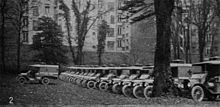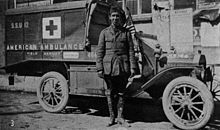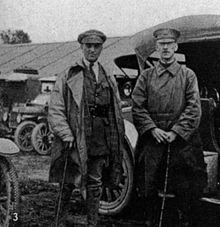When war broke out in 1914, the American Colony of Paris organized an "ambulance"—the French term for a temporary military hospital—just as it had done in the Franco-Prussian War of 1870 when the "American Ambulance" had been under tents set up near the Paris home of its founder, the celebrated Paris-American dentist, Dr. Thomas W. Evans. The "American Ambulance" of 1914 took over the premises of the unfinished Lycée Pasteur in the suburb of Neuilly-sur-Seine—and was run by the nearby American Hospital of Paris.
The volunteer drivers of 1914 found themselves behind the wheels of motorized, not horse-driven, vehicles: Model-Ts, purchased from the nearby Ford plant in Levallois-Perret.
In the fall of 1914, when the war front moved away from Paris, the American Ambulance set up an outpost in Juilly and sent out detached units of volunteer drivers to serve informally with the British and Belgian armies in the north. In early 1915, one of those drivers—A. Piatt Andrew—was appointed “Inspector of Ambulances” by the head of the American Ambulance, one of his colleagues from the Taft Administration. In April 1915, Andrew succeeded in soliciting an agreement from the French High Command authorizing "foreign sanitary sections" to work at the front as part of the French Army Automobile Service This marked the formal beginning of American Ambulance Field Service, three units of which would made their mark during battles in northern France, the Champagne, Verdun and the Vosges.
By the summer of 1916, the Field Service severed its ties with the American Ambulance and moved its operations from cramped quarters in Neuilly to Paris, onto the spacious grounds of the Delessert château at 21 rue Raynouard in the Passy. There, it grew rapidly over the next year, continuing to provide "sanitary sections" to the French Army, while also serving as a recruitment source of combat pilots for the newly-formed Escadrille Lafayette, one of whose prime movers, Dr. Edmond Gros, was the Field Service’s in-house physician.
When the United States entered the war in April 1917, the French Army successfully appealed to the Field Service for drivers for its military transport sections —and so, no longer limited to medical transport, the organization renamed itself the “American Field Service”, thus establishing today’s well-know acronym, “AFS”.
Before the AFS was absorbed into the much larger, federalized U.S. Army Ambulance Service, it had numbered more than 2500 volunteers, including some 800 drivers of French military transport trucks. It had actively recruited its drivers from the campuses of American colleges and universities, promoting morale by creating units with volunteers from the same schools. All financed their own uniforms and transportation to France where they worked under the same conditions as French ambulance drivers—with the same pay—and often found themselves serving under extremely dangerous missions on the Front. By the end of the war, some 127 men who had served with the AFS were killed and a notable number of individuals and units earned the Croix de Guerre and the Médaille de Guerre for their heroic actions as drivers.
Other volunteer ambulance corps served the French Army as “foreign sanitary sections” during World War I. The first was Henry Harjes’ “Formation” units under the American Red Cross, followed by Richard Norton’s American Volunteer Motor-Ambulance Corps, organized in London under the St. John’s Ambulance (the British Red Cross). Later, both would merge —under the American Red Cross—as the “Norton-Harjes”. In the summer and fall of 1917, when all the volunteer ambulance services were invited to join the new U.S. Army Ambulance Service, Norton’s units simply disbanded, while Harjes’, under the American Red Cross, moved into Italy where they would subsequently serve under the USAAS.
Once the Americans entered the war, many drivers joined combat units, both French and American, serving as officers in a wide variety of assignments, notably in air force and artillery units. At the same time, .a large percentage of volunteers signed up for the military, thenceforth members of USAAS units, but remaining identified with their AFS past—a past kept alive through the work of HQ, still at 21 rue Raynouard, where a Bulletin was published and where visiting ambulance drivers could find temporary lodgings and meals.
Following the Great War, the AFS became sponsors for the French Fellowships—graduate student scholarships for study in France and in the US—which were ultimately administered by the Institute of International Education and were precedents for the Fulbright Foundation exchanges. AFS also created an association for its veterans, publishing a bullletin, organizing reunions and contributing a wing to house its memorabilia at the Museum of Franco-American Cooperation in Blérancourt, France.
When World War II broke out, AFS reorganized its ambulance service, sending units first to France and then to the British Armies in North Africa, Italy, India-Burma and with the Free French for the final drive from southern France to Germany.
In September 1946, Stephen Galatti, president of AFS, established the American Field Service International Scholarships. During the 1947-48 school year, the first students came from ten countries including Czechoslovakia, Estonia, France, Great Britain, Greece, Hungary, the Netherlands, New Zealand, Norway and Syria.
Modern Day
As of 2008 there are over 55 AFS organizations worldwide, serving over 80 different countries, providing exchange opportunities for over 14,000 students and teachers annually.
AFS is one of the largest volunteer-based organizations of its kind in the world with more than 30,000 volunteers worldwide and more than 8,000 in the U.S. Tens of thousands of volunteers and a small staff make the AFS program happen worldwide. AFS volunteers are both young and old, busy professionals and retirees, and students and teachers. AFS provides development and training opportunities for volunteers.
AFS volunteers help in many areas including facilitating the AFS mission in the local community and schools by finding and interviewing students and families. Further involvement includes serving as a contact person for an AFS student, organizing fund raising events, and arranging activities for AFS students. As a volunteer-driven organization, AFS depends on donations of time to implement and monitor the delivery of programs.
|
Early years

The remains of two ambulances destroyed by German shell-fire brought to Paris

21 ambulances in the yard at 25 Rue Raynouard in Paris

The American Ambulance Field Service convoy near Dombasle-en-Argonne in 1917

Julien Bryan in front of his Ambulance 464 in April 1917 near Verdun

A. Patt Andrew, director of the Field Service and Major Church, U. S. A., visiting in Champagne.

Cyrus Leroy Baldridge in the uniform of the American Field Service, 1918
|